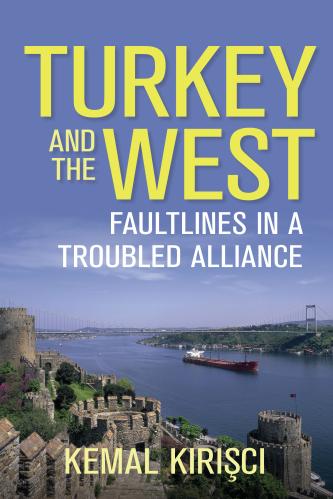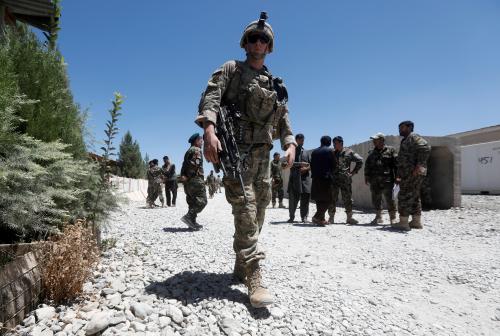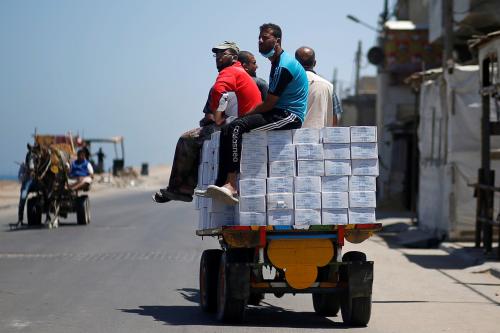President Biden’s decision to bring the remaining U.S. troops home from Afghanistan by Sept. 11 could potentially launch a mass exodus of refugees fleeing Afghanistan and spark another migration crisis, argues Kemal Kirişci and Fulya Memisoglu. Given Biden’s campaign promise to revive U.S. “moral leadership,” the United States must devise concrete ways to protect Afghan refugees. This article originally appeared on Just Security.
President Joe Biden’s decision to bring the remaining U.S. troops home from Afghanistan by Sept. 11, the 20th anniversary of al-Qaeda’s attacks on the United States that launched America’s longest war, has prompted an array of criticism. Mainly, commentators argue that the Taliban now has the upper hand, with no incentive to negotiate with the Afghan government, and that it is unlikely to respect the fragile gains made on democracy, freedom of expression, and especially the empowerment of women. Intelligence analysts predict a civil war and potential resurgence of al-Qaeda, as happened after the U.S. withdrawal from Iraq.
But these reactions leave out another potentially catastrophic ramification that is likely to flow from any of those consequences, and might even occur in anticipation of the shift: a mass exodus of refugees fleeing Afghanistan that could spark another migration crisis.
While perhaps not immediately affecting U.S. security, such mass displacement risks adversely impacting America’s allies across the Atlantic, especially the European Union (EU). During the summer of 2015, the arrival in Europe on foot of more than a million refugees, mostly Syrian, resembled a “new odyssey” and shook the very foundations of the EU. It would be difficult to ignore a connection between the decision of the Obama administration to pull U.S. troops out of Iraq in 2011, the rise of ISIS three years later, the ensuing regional insecurity marked by its brutal rule over a swath of Iraqi and Syrian territory, and how this led to additional displacement of Syrians beyond those who had already fled to neighboring countries. Furthermore, U.S. inaction in the face of such a displacement crisis, should it occur in the case of Afghanistan, would further damage U.S. standing in global affairs, especially when Biden is seeking to reassert U.S. “moral leadership” globally.
As the U.S. military begins the final phase of its drawdown on May 1, it is urgent to begin thinking about a potential response to such a mass displacement.
The Troubled Destiny of Afghans
Beginning with the Soviet invasion of Afghanistan in 1979, Afghan civilians have suffered a long history of displacement. In the 1980s and 1990s, they constituted by far the largest refugee population in the world, mostly living in Pakistan and Iran. Their situation became protracted, as none of the traditional durable solutions in the form of voluntary return, resettlement, and local integration were available to them in any significant manner. The Taliban’s arrival in Afghanistan in 1996 provoked further displacement once it consolidated its harsh rule over the country.
Only after the U.S.-led NATO intervention in 2001 and the arrival of some modicum of stability did Afghans begin to return. And they did so en masse. Since 2002, a voluntary repatriation program supported by the United Nations Refugee Agency (UNHCR) facilitated the return of nearly 5.3 million refugees, although the returns have slowed considerably in recent years.
At the end of 2019, Afghans still constituted the third-largest forcibly displaced population in the world, at almost 6 million refugees and internally displaced people, with some 380,000 added in 2020 alone. Due to persistent insecurity and instability in Afghanistan, coupled with economic and environmental challenges, external and internal displacement are often intertwined, as people are forced to move repeatedly either within the country or across borders. Although the Afghan economy has almost doubled in size since 2007, Afghanistan still ranks 169th (out of 189 countries) on the U.N.’s 2020 Human Development Index, particularly due to its fragile education and healthcare systems. As one expert noted, under these conditions, Afghans have long used mobility as a coping mechanism, “and they are unlikely to stop any time soon.” Scarce socio-economic prospects in neighboring Iran and Pakistan, which host 87 percent of Afghan refugees, is leading to secondary migration by Afghan youth and some desperate families hoping to find sustainable livelihoods in Europe.
Unknown Destination
Unsurprisingly, Afghans are among the top nationalities seeking asylum in the EU or apprehended by European authorities as irregular migrants, and they were the second-largest group that traveled to Europe during the 2015-16 migration crisis. But the number of Afghan arrivals decreased considerably after the implementation of the EU-Turkey Statement of March 18, 2016, under which Turkey agreed to accept Syrians returned from the EU and help prevent further migration to the bloc (via Greece) in exchange for 6 billion euros of financial assistance and a promise to resettle one Syrian refugee for every irregular migrant Turkey took back from Greece. As a result, EU arrivals dropped from 37,494 between January and March 2016 to 2,778 in the following nine months.
But in 2019, Afghan arrivals to the EU doubled. By early 2020, they were the largest group among all sea arrivals to Greece (36 percent), before numbers once again declined due to movement restrictions implemented in response to the COVID-19 pandemic. Asylum applications in the “EU+” area (30 countries, including 26 of the 27 EU members and four that use the Schengen visa regime: Iceland, Liechtenstein, Norway, and Switzerland) dropped 43 percent between February and March 2020 due to such restrictions. In the first two months of that year, Afghans had constituted the second-largest group of applicants (13,245).
In the meantime, Turkey has become a destination and a vital hub for Afghans heading towards Europe. The March 2016 EU-Turkey agreement required the Turkish government to close its borders to onward irregular migration to be able to benefit from the EU funds it was promised to support Syrian refugees, leaving most Afghans with no way forward, even irregularly. According to the Turkish migration agency, almost half a million Afghan irregular migrants were apprehended between 2014 and 2020, jumping from 45,259 in 2017 to 100,841 in 2018, and reaching 201,437 in 2019. These figures are only the tip of the iceberg, as it is very difficult to estimate the actual number of Afghans irregularly present in Turkey. Afghans also constitute the second-largest group of asylum-seekers in Turkey, at 116,400 asylum applications. This was driven in part by increased secondary movements of Afghans from Iran to Turkey due to Iran’s sharp economic downturn in 2018, following the reimposition of U.S. sanctions when the Trump administration withdrew from the nuclear deal.
Syrian refugees enjoy a legally defined status in Turkey and benefit from access to public services and social assistance, and they feel increasingly settled. But Afghans, especially those who are undocumented, find that their lives are on hold in Turkey’s big cities and struggle to earn enough to support themselves and their families. They also face a constant threat of deportation.
Not surprisingly, nearly 50 percent of Afghans in a recent survey indicated they had not reached the end of their migration journey and intended to move onward to Europe, citing a lack of secure legal status and access to employment in Turkey. Hence, when Turkish President Recep Tayyip Erdoğan in February 2020 carried out his longstanding threat to the EU that “We will open the gates and send 3.6 million refugees your way” and precipitated a major migration crisis again, many more Afghans turned up at the Greek border than Syrians.
In a future exodus from Afghanistan, the migrants would again most likely make their way West to Iran and Turkey. But unlike in 2015-2016, new mass migration this time may occur amid a still-raging pandemic, considering the slow pace of improvement and vaccination in most countries. In Afghanistan, for starters, the ongoing conflict, a weak healthcare system, an insistence on tradition, and a general lack of reliable public information has left most Afghans simply denying the reality of the coronavirus. While a vaccination campaign has begun, the health ministry hopes to reach only 20 percent of the population by the end of this year.
The next likely stop for any Afghan refugee, Iran, has suffered the worst COVID-19 outbreak in the Middle East and has seen its economy crippled by a combination of U.S. sanctions and the raging pandemic. The country recently implemented a 10-day lockdown with a fourth surge of infections. Turkey’s daily number of reported cases soared from 5,642 on Jan. 25 to a peak of 63,082 on April 16, the highest level since the government began to share these figures with the public at the end of November. Though Turkey’s vaccination campaign had been proceeding rapidly, delays in the supply of China’s Sinovac inoculation caused a stumble. Health Minister Fahrettin Koca recently announced that “vaccine diplomacy” has ramped up to obtain whatever vaccines are available.
In the meantime, Iran’s less welcoming environment for Afghan refugees and migrants took a new turn in late 2020 under a draft law targeting undocumented Afghans. Such a policy may trigger further secondary movements to Europe via Turkey. It is unlikely that Turkey would be able to stop such an influx. Turkey currently hosts the largest refugee population globally and could face another wave of displacement from Syria should Russia give the Syrian regime the green light to reclaim territory under opposition and Turkish control. Furthermore, the Turkish economy is doing poorly, and public opposition to the government’s policy of hosting Syrian refugees is intense.
Under these circumstances, a new migration crisis is not difficult to imagine. If the EU and its member, Greece, choose to close the border and use force to repel Afghan refugees, this would not only provoke a humanitarian catastrophe, but also lead to a huge standoff pitting Greece, the EU, and Turkey – all U.S. allies – against each other. With the EU’s own difficulties in bringing the COVID-19 pandemic under control, the impact of such a combined health and migration crisis might carry much more serious consequences for the EU’s stability than the migrant crisis in 2015-16, further undermining EU institutions and fueling right-wing populism.
What to Do?
Secretary Blinken has sought to reassure Afghan President Ashraf Ghani and Afghan High Commission for National Reconciliation Chair Abdullah Abdullah of U.S. support for “our shared investment in Afghanistan and the importance of preserving the gains of the last 20 years, especially in building a strong civil society and protecting the rights of women and girls.” Time will tell whether that pledge will have meaning. A realistic assumption is that, once U.S. forces depart, the Taliban may be able to take over once again and reinstate the harsh rule that made it notorious in the 1990s. It also may again provide fertile ground for international terrorism threatening the United States and its allies.
Now is the time to devise concrete ways to protect the hard-won gains that Afghans achieved with the help of the United States and its allies, before the Afghans who cherish that progress begin to flee their country in large numbers. There should be an additional effort made, for example, to accelerate efforts to bring to the United States those Afghans and their families who assisted Americans and U.S. institutions there, since they are likely to face heightened risks to their lives as U.S. forces withdraw.
Additionally, a proactive dialogue with the EU as well as with transit countries such as Iran and Turkey will be of paramount importance if a major humanitarian crisis with severe political consequences is to be avoided. How to render humanitarian assistance to refugees while preventing further spread of the coronavirus will be an important part of this dialogue, in addition to exploring ways to ensure that these refugees do not join the ranks of their predecessors who still live in limbo.
To do this, a global comprehensive plan to help resettle Afghan refugees will be needed, perhaps one akin to the 1989 “Comprehensive Plan of Action for Indochinese Refugees” that was adopted for the “boat people” fleeing Vietnam in the aftermath of the 1975 fall of Saigon. But that plan was devised only after years of mass displacement and after earlier agreements to address the crisis had failed. The United States and its allies should learn from those experiences and take proactive steps this time.
Given Biden’s campaign promise to revive U.S. “moral leadership” in defense of refugees and a rules-based international order, such an initiative would be imperative. It would also be in line with the principle of burden-sharing for the protection of refugees enshrined in the 1951 Geneva Convention Relating to the Status of Refugees, adopted as part of U.S. led post-World War II international order, and reiterated in the Global Compact on Refugees adopted in December 2018.
The Biden administration’s recent missteps on increasing U.S. refugee resettlement quotas are an indicator that a forward-thinking, multilateral response will be necessary, due to the sharp political divisions facing the U.S. immigration debate. Afghans, for one, will need more opportunities for resettlement in the United States than the meagre 16,300 places they were granted between 1987 and 2015. The administration will need to accompany such efforts with a domestic communication strategy to defuse the all-too-common opposition to immigration among skeptical Americans and promote the benefits, both in foreign policy and to the economy, of accepting Afghan – or any – refugees and other migrants.
An America that actively protects the less fortunate, including by supporting refugees, would serve its own national security interests by bolstering its economic dynamism at home, enhancing its reputation in a global “battle of ideas,” heightening U.S. “soft power,” and helping stabilize countries in the Middle East and even in Europe that host the majority of migrants. A renewed emphasis on human rights through supporting refugees would strengthen the hand of an American administration confronting China, Russia, and other authoritarian regimes on their rights abuses.
Finally, and possibly most importantly, such a proactive policy response coinciding with July’s 70th anniversary of the 1951 Refugee Convention would demonstrate the political will and the leadership not to repeat the mistakes the international community made before World War II, when the United States and others turned away Jewish refugees fleeing Nazi Germany. Those decisions and their consequences have been a source of perpetual horror and shame for the United States and the international community ever since. The Biden administration has an opportunity to prevent such wholesale neglect of refugees going forward.
The Brookings Institution is committed to quality, independence, and impact.
We are supported by a diverse array of funders. In line with our values and policies, each Brookings publication represents the sole views of its author(s).









Commentary
Biden’s decision to pull troops from Afghanistan risks a major refugee crisis
April 26, 2021